free to be able to rate and comment on reports (as well as access 1:25000 mapping).
One more story about a plane lost in the wild world of Scottish mountains...
After visiting the graves on Conival, we hoped to find and photograph another crash site in the far north of Scotland, this one situated on the upper slopes of Cranstackie. We had climbed Cranstackie and Beinn Spionnaidh a few years ago, following the traditional route up Calbhach Coire with a slight modification (descending via Cioch Mhor). I knew there was a crash site there somewhere, but when I told Kevin that the plane was a Mosquito, he doubted if there was much left of it to investigate. But I have recently found out that there is indeed a substantial amount of debris left on the slopes, and the direttisima up Cranstackie looked an interesting challenge

so the plan was hatched. Next time weather is good up north, we go for it!
Before I get to the details, I'd like to thank EmmaKTunskeen for her lovely report and details about how to find the crash site

So this is how our route ended up. We planned to visit the crash site and then climb Cranstackie, Beinn Spionnaidh was optional depending on weather. As conditions improved in the afternoon, we added the second Corbett as well, returning via Calbhach Coire:
The morning was very cloudy and the forecast was for better conditions in the afternoon, so we deliberately delayed the start, arriving in Carbreck at half past ten. The walk according to WH, should not take more than 8 hours, even if you spend half of that time scanning slopes for plane parts.
I wasn't very happy with the way things were unfolding, it was cold and quite windy, heavy cloud hanging over the two Corbetts.
It doesn't look good...
Kevin had his new GPS well secured, I told him to keep an eye on it - losing another one was out of question

We walked past Rhigolter and started the climb, initially very easy on a proper track:
Looking down the track to the Rhigolter farm:
We reached a fenced-off area, climbed over the gate (it was easier to just clamber over it than try to untangle the strings). We crossed the pasture, following a faint path, trying to avoid high bracken. A few sheep watched us with little interest:
We passed a second gate and crossed Allt Calbhach Coire, aiming directly for the summit of Cranstackie. The clag was slowly lifting and the direttisima didn't look particularly difficult, steeper than the traditional approach via the corrie, but certainly not a big challenge:
Farrmheall, a lower Marylin across Strath Dionard:
Initially, the ground was grassy, with scattered boulders, later on it became more rocky, to turn into a proper boulder-hopping experience near the summit. But at the moment, we concentrated on trying to locate the debris field, which according to internet sources should start at 550m. One of the sources had grid references for the crash site, so Kevin's GPS was a great help

About half way up, we began to scan the ground for the first signs of the lost plane. Above us, the summit of Cranstackie was beginning to clear:
The first part we found was a mysterious oval-shaped piece of rubber. Kevin suggested it might have been a piece of agricultural equipment, but my nose was telling me, we were on the right path!
Only a few meters from that first find, we discovered a large metal piece, which according to Kevin, definitely belonged to a plane. One of the sources I read suggests this was a part of the aircraft elevator:
Some small pieces of debris were also scattered around:
I noticed more remains a bit to the left so I went there to have a better look, leaving Kevin to scan the slopes to our right hand side.
What I found was mostly broken metal pipes:
...and unidentified aluminum debris, obviously parts of the fuselage:
...but as we climbed higher to look for more, I heard Kevin gasping "yea!". I turned my head towards Beinn Spionnaidh and... ba-da-dum! The cloud was gone! We were going to have a nice, clag-free ridge walk, hooray!
The main debris field is at the height of 600-650m, in a straight line below the summit crags:
The ground became more rocky as we gained height. We found more and more debris, mostly wedged between the rocks:
I was surprised how badly mangled the metal parts were. Kevin suggested, the plane must have hit the slope at its full speed to cause damage like that.
I noticed a few parts definitely affected by high temperature, like this half-melted piece of aluminum:
It was impossible to guess the exact impact spot. Some of the previous sites we visited had an obvious crater where the aircraft hit (the Firefly from Lochnagar for example), but here, it was just the neverending debris field, with small parts made of metal, wood and rubber scattered everywhere.
Most of the debris is hard to name, the rusty parts are likely from the undercarriage:
It was the first site where I saw so much internal wiring still scattered around, some wires attached to larger parts of the plane:
A fragment of the metal binding used to hold the wooden parts together (I know my language is far from technical, apologies for that):
I bet we didn't photograph every single part. What Kevin was looking for, was the engines of the Mosquito. They should be seen from the distance, as they were of a similar shape/size as in Avro Lancaster. The ones on Beinn Eighe could be seen from far distance, so we expected to spot them here as well, but no luck...
We discussed this piece for a few minutes - a wing tip or perhaps a part of the tail?
There's more...
...and more...
...it just goes on forever!
Partially squashed radiator:
Kevin began to wonder - we couldn't find the engines, perhaps because they fell apart on the impact?
Higher up we found the source of the mysterious rubber ring - it came from the undercarriage suspension mechanism, we spotted the rest of it still in one piece:
Looking down the "direttisima" route with a few parts of the Mosquito on the ground:
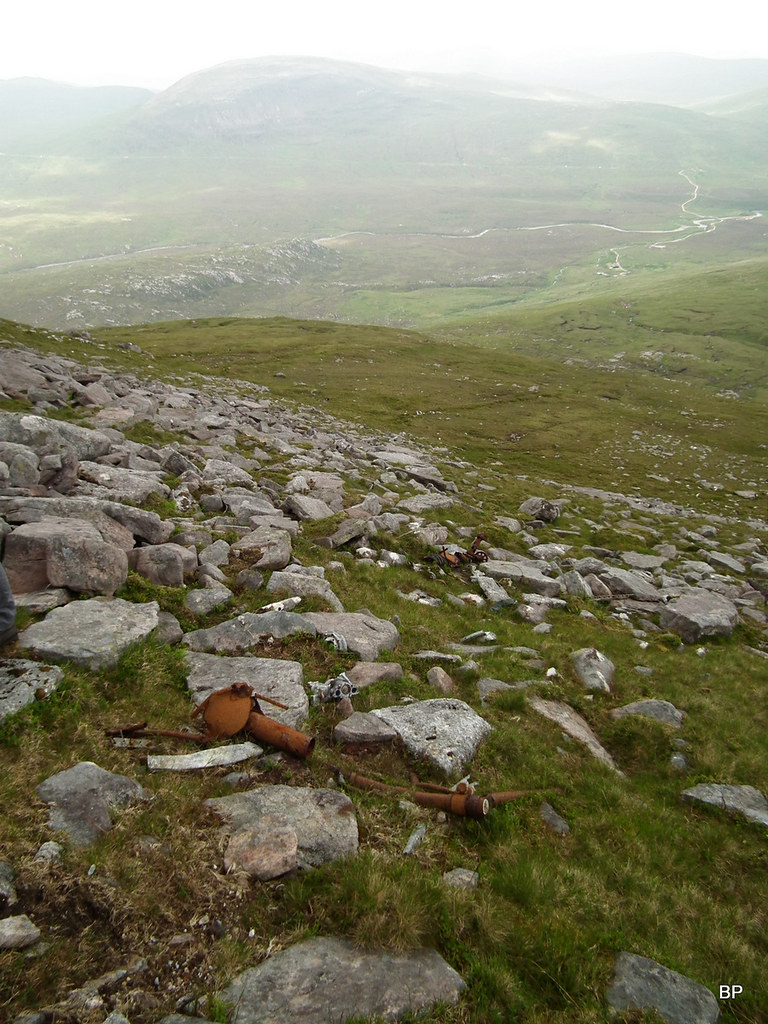 2019-06-29 cranstackie 103
2019-06-29 cranstackie 103 by
Ewa Dalziel, on Flickr
More parts of undercarriage:
A gear wheel of some sort??
I was shocked how much of this plane still remains on the mountain, considering it was a Mosquito. We kept climbing and even when we thought we must have passed the impact zone, we found more wreckage, so mangled it was impossible to name:
A part of the main frame:
The next pile of debris we located included the carburetor, and possibly parts of the smashed engine:
Just to the left, I spotted another radiator:
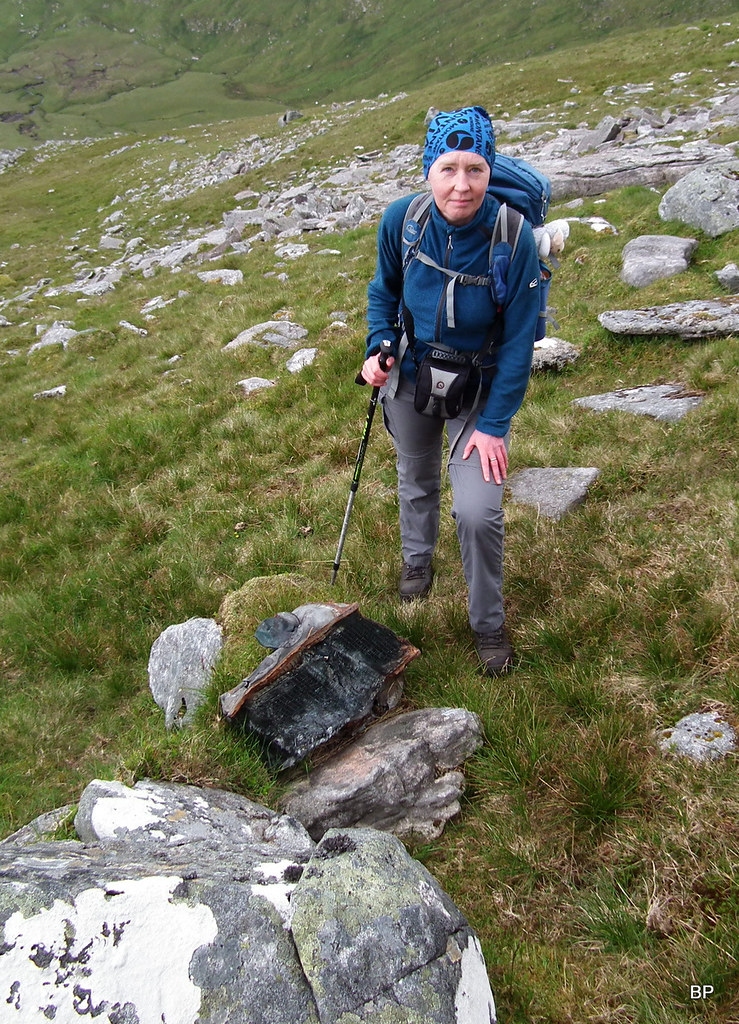 2019-06-29 cranstackie 128
2019-06-29 cranstackie 128 by
Ewa Dalziel, on Flickr
Squashed water tank from the radiator, most likely:
The last part we located, the pilot’s seat back armour:
Apologies for all the "possibly", "maybe", "most likely" and "could be" phrases in description, sadly my knowledge in plane construction is obviously limited. But even a complete ignorant like me could plainly see, that the Mosquito must have smashed into the side of Cranstackie at full speed, to cause so much damage (also there was fire as some pieces of aluminum were melted). So what caused the accident?
I did my online research, and there is very little information about this particular crash, much less than about the previous sites we visited. But it doesn't mean this story is less interesting...
....................
The Mosquito, or to be precise, the de Havilland DH.98 Mosquito was a twin-engine combat bomber, first introduced during the Second World War. Due to its mostly wooden frame, it was nicknamed The Wooden Wonder or Mossie. Originally designed as a fast bomber, it was used for multiple tasks including: low to medium-altitude daytime tactical bomber, high-altitude night bomber, pathfinder, day or night fighter, fighter-bomber, intruder, maritime strike aircraft...
OK, enough of Wikipedia knowledge. This particular Mosquito (Mk.IV DZ486 of No.618 Squadron, RAF) was taking part in a bombing exercise from Skitten near Wick, on 5th April 1943. One of the sources I read suggested that it might have been testing the new Barnes Wallace anti-shipping bouncing bomb, which were concrete-filled for the test drops. According to Wikipedia
"27 B Mk IVs were converted for special operations with the Highball anti-shipping weapon, and were used by 618 Squadron, formed in April 1943 specifically to use this weapon."Of course, we didn't find any bomb cases in situ. Possibly, they had been dropped before the plane crashed. Regardless of what type of exercise was performed that day, it looks like the plane must have flown over Loch Eriboll before clipping the ridge to the north of the summit and then it completely disintegrated, parts of fuselage tumbling down the north western face of Cranstackie. Both crew members died instantly: Flying Officer Donald Pavey (the pilot) aged 21 and Sgt. Bernard Stimson (navigator/air bomber) aged 28. Two more young lives lost to the efforts of war...
I couldn't find any info about weather conditions that day, but one of the sources states that "
the aircraft flew into the mountain at cruising speed" which suggests they probably didn't see the hill, so cloud must have been low. The optimum cruising speed for the Mosquito is 200mph. That explains why the remains of the plane are so badly mangled.
...........
In our pilgrimages to different plane crash sites, this was the first time we didn't see any memorial plague. It's a shame that the crew of this Mosquito don't have a little memorial

When we reached the top of the debris field, we stopped for a minute of silence. Every time I visit a place like this one, different feelings run through me, different thoughts bounce around in my head, from deep sadness to gratitude. So many years ago, young men like the crew of this Mosquito, fought the war so we could now enjoy our life in peace. I know, it sounds so cliche, but it's a fact. They deserve to be remembered.
..............
Moving on from the sad experience of the crash site, we continued our "direttisima" climb to the summit of Cranstackie. higher up, the ground became more bouldery and a lot of rock-balancing was required to stay upright:
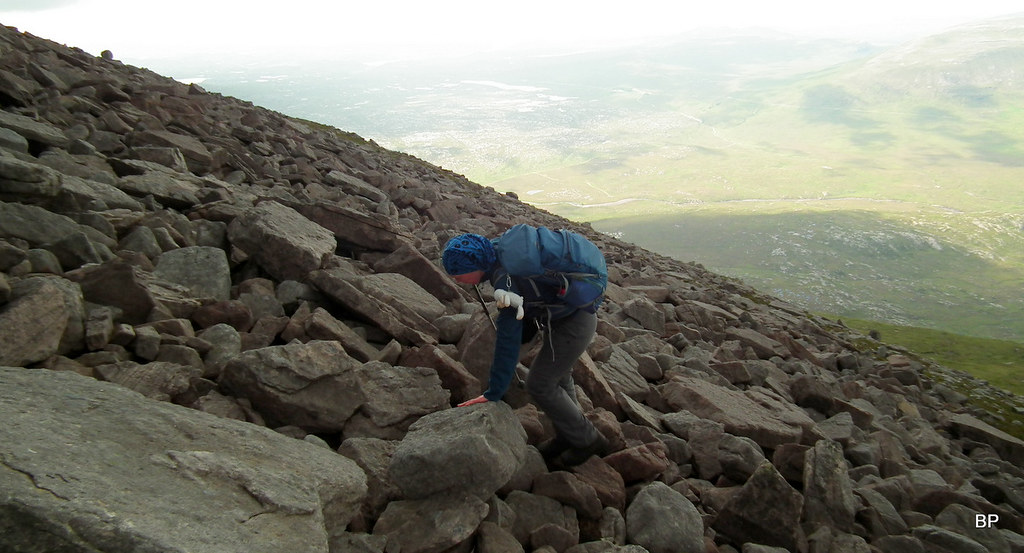 2019-06-29 cranstackie 139
2019-06-29 cranstackie 139 by
Ewa Dalziel, on Flickr
Just below the summit, Kevin sniffed a good scrambling opportunity. It can be avoided of course, but try stopping the man


We reached the summit just as the last remnants of the cloud lifted off the top. it was a repeat for all of us, including wee Lucy, but she had to pose for her "veni vidi vici" picture (though in this case it should be "veni vidi vici baaa" )


 2019-06-29 cranstackie 162
2019-06-29 cranstackie 162 by
Ewa Dalziel, on Flickr
Black Panther also had her moment of madness... Foinaven in the background.
 2019-06-29 cranstackie 164
2019-06-29 cranstackie 164 by
Ewa Dalziel, on Flickr
Zoom to Balnakeil Bay:
 2019-06-29 cranstackie 167
2019-06-29 cranstackie 167 by
Ewa Dalziel, on Flickr
The ridge of Foinaven - zoomed:
 2019-06-29 cranstackie 177
2019-06-29 cranstackie 177 by
Ewa Dalziel, on Flickr
Kevin on the summit, with Beinn Spionnaidh behind. As the weather has improved, we decided to take in the second Corbett as well:
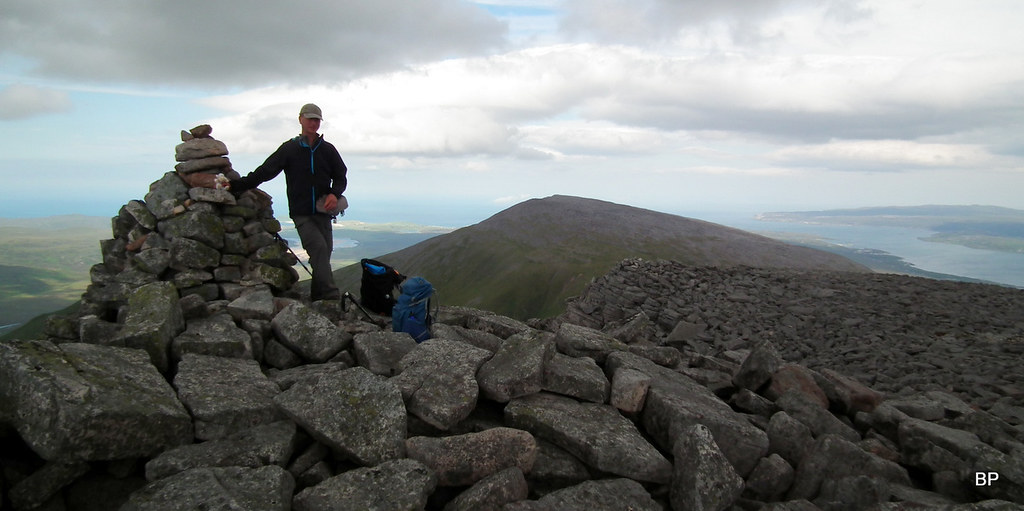 2019-06-29 cranstackie 185
2019-06-29 cranstackie 185 by
Ewa Dalziel, on Flickr
After a short snack and tea break, we continued our traverse to Beinn Spionnaidh. The initial descent from Cranstackie is a bit rough, but nothing technical:
 2019-06-29 cranstackie 193
2019-06-29 cranstackie 193 by
Ewa Dalziel, on Flickr
A bit wobbly on the way down:
 2019-06-29 cranstackie 200
2019-06-29 cranstackie 200 by
Ewa Dalziel, on Flickr
Facing Beinn Spionnaidh:
 2019-06-29 cranstackie 204
2019-06-29 cranstackie 204 by
Ewa Dalziel, on Flickr
Looking back to Cranstackie from the slopes of Spionnaidh - panoramic version:
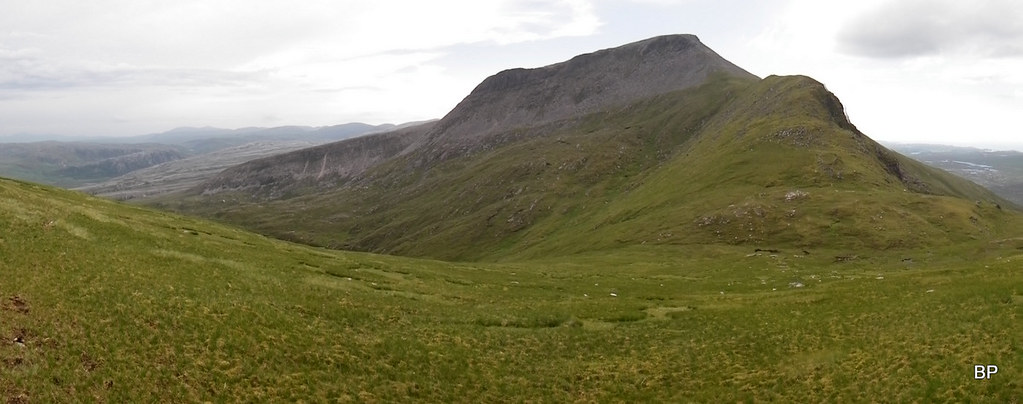 2019-06-29 cranstackie 218
2019-06-29 cranstackie 218 by
Ewa Dalziel, on Flickr
Just below the summit of the second Corbett we had a nice surprise. I'm no bird expert but certainly this is an eagle!
 2019-06-29 cranstackie 221
2019-06-29 cranstackie 221 by
Ewa Dalziel, on Flickr
Nearly there! The final 50m or so of the ascent to the second summit is rocky, but no scrambling, just some boulder hopping...
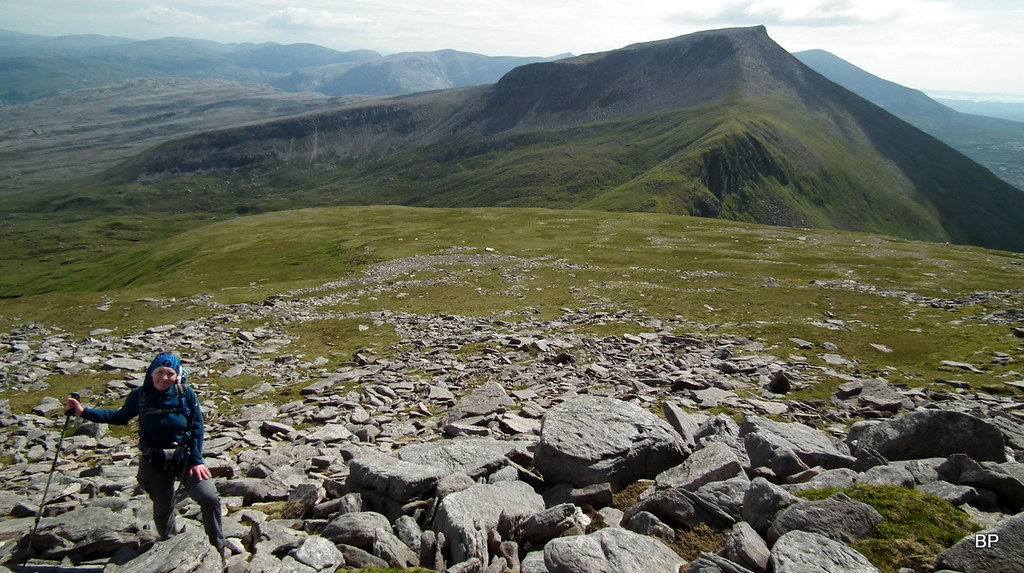 2019-06-29 cranstackie 226
2019-06-29 cranstackie 226 by
Ewa Dalziel, on Flickr
...and great views in all directions. Beinn Spionnaidh is a good viewpoint to the north:
 2019-06-29 cranstackie 250
2019-06-29 cranstackie 250 by
Ewa Dalziel, on Flickr
Looking back south from the summit of Beinn Spionnaidh, the outline of Foinaven ridge on the horizon:
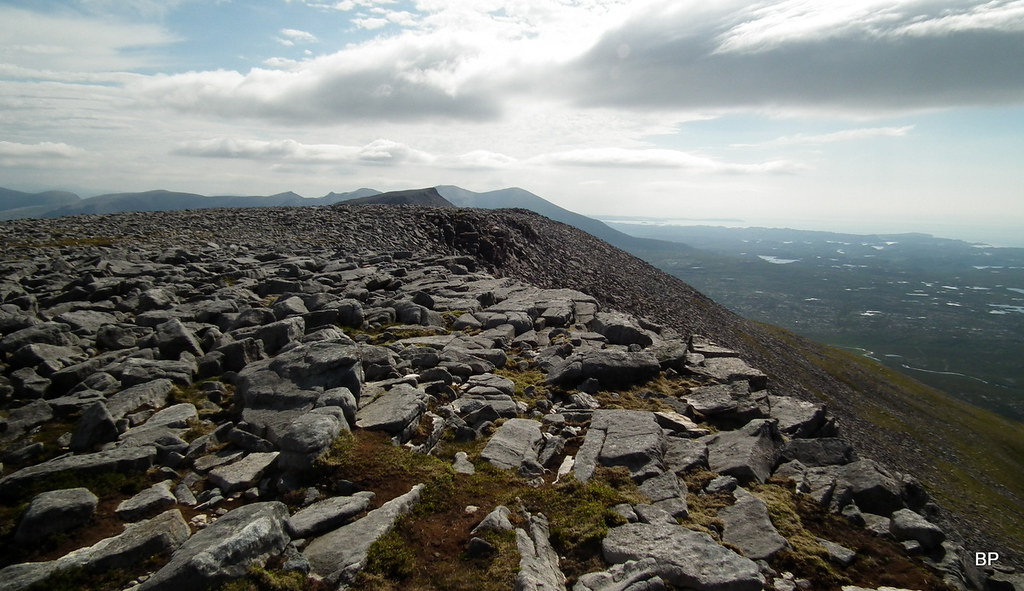 2019-06-29 cranstackie 239
2019-06-29 cranstackie 239 by
Ewa Dalziel, on Flickr
To the east, some darker weather, cloud hanging over Ben Hope:
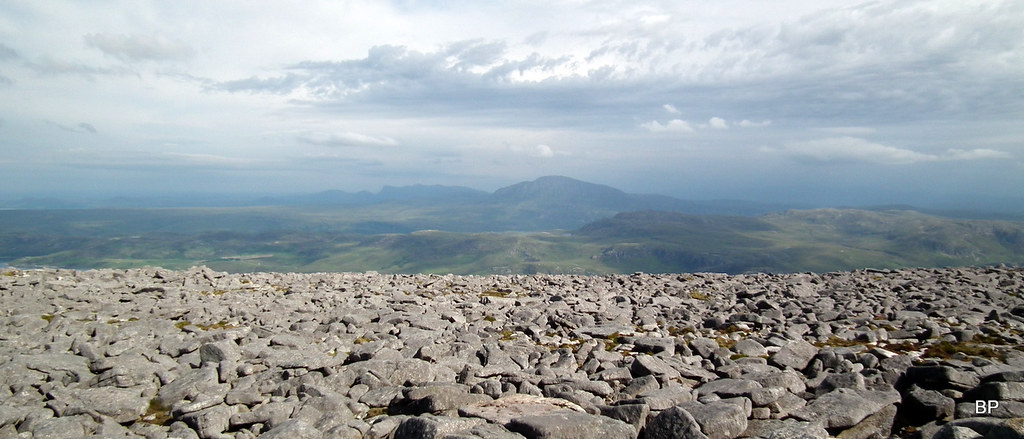 2019-06-29 cranstackie 241
2019-06-29 cranstackie 241 by
Ewa Dalziel, on Flickr
...but there was nothing dark about my mood now!
 2019-06-29 cranstackie 245
2019-06-29 cranstackie 245 by
Ewa Dalziel, on Flickr
We stayed on the summit far longer than we should have, sinking in the views. At some point, we noticed we had a little companion, a red admiral butterfly:
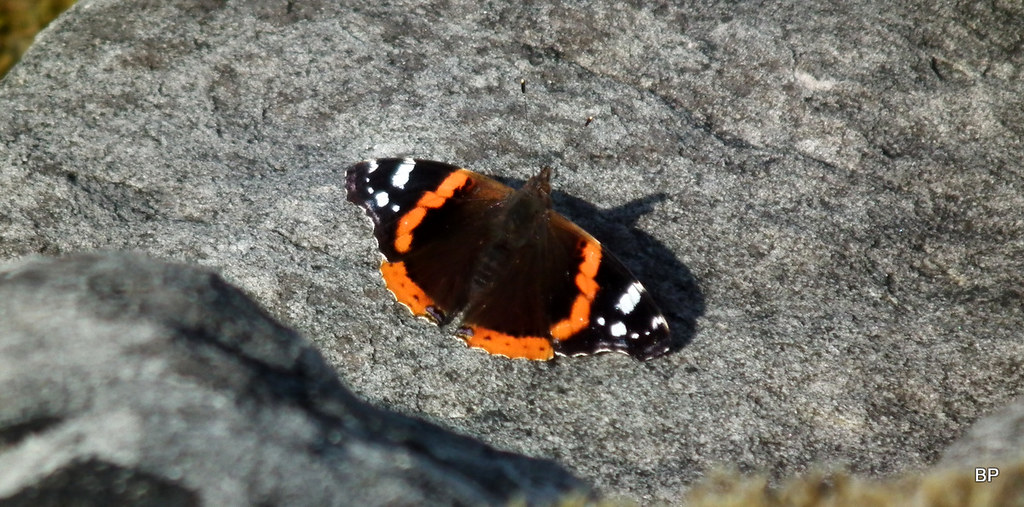 2019-06-29 cranstackie 258
2019-06-29 cranstackie 258 by
Ewa Dalziel, on Flickr
Panoramic view north from Beinn Spionnaidh:
 2019-06-29 cranstackie 261
2019-06-29 cranstackie 261 by
Ewa Dalziel, on Flickr
Zoom to Hope and Loyal:
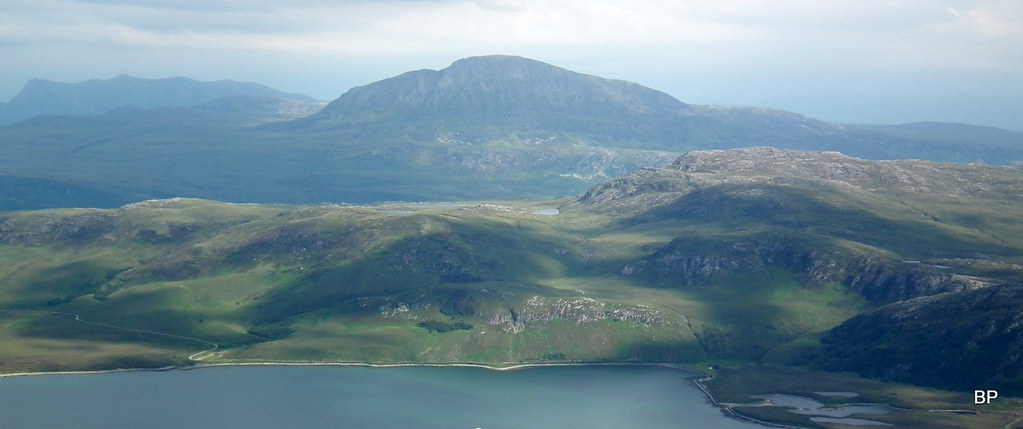 2019-06-29 cranstackie 268
2019-06-29 cranstackie 268 by
Ewa Dalziel, on Flickr
Views south-east:
 2019-06-29 cranstackie 269
2019-06-29 cranstackie 269 by
Ewa Dalziel, on Flickr
On our previous visit here, we descended via this ridge (Cioch Mhor). Highly recommended if you want to do a circular:
 2019-06-29 cranstackie 240
2019-06-29 cranstackie 240 by
Ewa Dalziel, on Flickr
...but on this occasion, we decided to return via Calbhach Coire as we wanted to look for more plane debris. The descent was OK, not too steep and on green grass mostly:
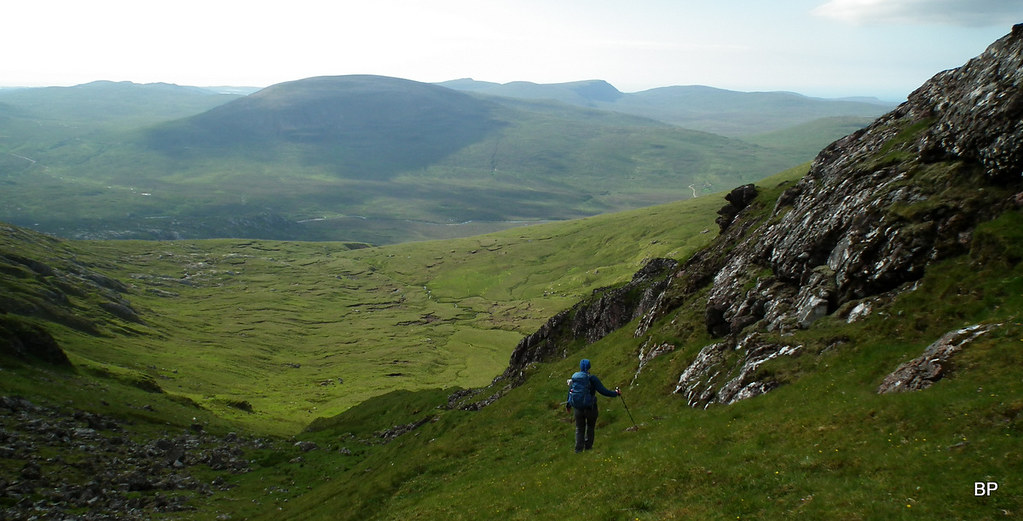 2019-06-29 cranstackie 271
2019-06-29 cranstackie 271 by
Ewa Dalziel, on Flickr
We managed to locate a few extra pieces of the Mosquito, small aluminum parts of fuselage:
 2019-06-29 cranstackie 276
2019-06-29 cranstackie 276 by
Ewa Dalziel, on Flickr
Calbhach Coire from below, with both Corbetts in the frame:
 2019-06-29 cranstackie 281
2019-06-29 cranstackie 281 by
Ewa Dalziel, on Flickr
By the time we got back to Rhigolter, the high cloud was back but conditions were still all right for a final photo of Foinaven reflected in River Dionard:
 2019-06-29 cranstackie 290
2019-06-29 cranstackie 290 by
Ewa Dalziel, on Flickr
It is always nice to come back to the far north and spend a few hours in the wild world of Assynt and Sutherland. Despite having climbed all higher hills here, there is always something to re-visit and it's never a boring experience. In the case of Cranstackie, I'd recommend the "direttisima" - it might be steep all the way but it's more interesting than the classic route via Calbhach Coire.
...................
A lot has happened since our visit to Cranstackie and Beinn Spionnaidh, including the last WH Meet, loads of fun and happy rambling all over northern Scotland, including two more plane crash sites, a superb ruined castle, fantastic cliffwalking and bird watching experience, not to mention Munros, Corbetts and Grahams of different shapes and sizes. Now, with our holidays over, I can slowly sift through photos and prepare all my TR's: all 12 of them

.................
My next story will take us up some obscure Grahams, which would be very forgettable if it wasn't for views to the mighty Torridon and... yes, you guessed, another tragic plane crash story.
List of websites with information about the Mosquito plane and the crash site:
https://reflector.sota.org.uk/t/g4yss-gm-ns-038-cranstackie-mosquito-dz486-12-05-17/15273https://www.peakdistrictaircrashes.co.uk/crash_sites/scotland/de-havilland-mosquito-dz486-cranstakie/http://www.edwardboyle.com/wreck46.htmlhttps://en.wikipedia.org/wiki/De_Havilland_Mosquito